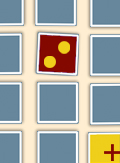The eLitMed.hu medical portal uses computer cookies for convenient operation. Detailed information can be found in the Cookie-policy.
Clinical Neuroscience - 2015;68(03-04)
Content
[Teriflunomide: new oral immunmodulant drug in therapy of multiple sclerosis]
[Multiple sclerosis (MS) is the autoimmune, demyelinating, neurodegenerative disorder of the central nervous system (CNS). There are nine drugs available in Hungary reimbursed by the National Health Insurance Fund of Hungary (OEP) to reduce the activity of the disease, from which seven can be used as first line therapies. We have approximately 20 years of experience with the interferon b-1a/1b and glatiramer-acetate products. Though in case of approximately 30% of the patients using one of the first line drugs, the disease remains active, that we call break-through disease. The reasons for break-through disease could be the insufficient adherence and compliance, the appearance of neutralizing antibodies or the high activity of the disease. One of the oral immunomodulating drugs for MS, teriflunomide, was registered in Europe in 2013. Because of the anti-proliferative and anti-inflammatory effect of teriflunomide, it can be used for the reduction of the disease activity in the relapsing-remitting course of MS. The effect of teriflunomide was proved in one Phase II. and four Phase III. (TEMSO, TOWER, TENERE, TOPIC) studies. Teriflunomide 14 mg once daily was able to demonstrate in two consecutive placebo-controlled phase 3 clinical trials that significantly reduces the relapse rate (31.5% and 36.3%) and in both studies significantly reduces the sustained disability progression (29.8% and 31.5%) moreover delays the appearance of the clinically definitive MS in patients with clinically isolated syndrome (CIS). According to the TENERE study there were no significant differences observed between teriflunomide 14 mg and IFNb-1a s.c. in time to failure and annualized relapse rate but the treatment satisfaction domains of global satisfaction, side-effects and convenience were significantly improved with teriflunomide compared with s.c. IFNb-1a. ]
[Proconvulsive effect of antiepileptic drugs]
[Antiepileptic drugs can provoke and worsen seizures, what is called paradoxical effect. Paradoxical seizure worsening can occur as a nonspecific manifestation of drug intoxication in number of antiepileptic drugs. The other type is a specific type, when antiepileptic drugs with pure GABAergic and sodium channel blocker mechanism of action provoke myoclonic, absence and atonic seizures in specific epilepsy syndromes, mainly in idiopathic generalized epilepsies. Antiepileptic drug-induced exacerbation of seizures is a common, often unrecognized clinical problem, which can be avoided by a careful syndromic diagnosis and by using broad spectrum antiepileptic drugs.]
[Drug therapy of neuropathic pain in mirror of latest reccommandations]
[Neuropathic pain is considered as a special type of different pain conditions. It’s pathophysiological basis and treatment is completely different from the nociceptive pain. The first comprehensive therapeutic guidelines published approximately a decade ago recommended tricyclic antidepressants, anticonvulsants and opioids. The recent summary presents and evaluates national and international guidelines issued in the last five years. The most frequently suggested drugs by all guidelines are amitriptyline, duloxetine, gabapentin and pregabalin. Pregabalin is the only drug that is recommended first line in all guidelines referred. Opioids are in the second or third line. There seems to be no major development in the pharmacological treatment of the neuropathic pain compared to the earlier recommendations. High quality studies of head to head comparisons and effectiveness of combination therapy are still lacking.]
[Do previous offences predict violent acts in psychiatric patients? A retrospective study in Hungary]
[Aim - To investigate the presence of offences in the previous past history of perpetrators of violent acts who have undergone forced medical treatment. Methods - The documentation of all patients released over a 10-year period from the National Institute of Forensic Psychiatry (IMEI) was reviewed. A comparison was drawn between patients who were convicted of any type of offense before the violent act (patients with previous offences-PPO) and those who were not (patients with no previous offences-PNO). Results - Eighty-six (29%) and 208 (71%) patients formed the PPO and PNO groups, respectively. Prior contact with psychiatric services was significantly higher in the PPO group (p=0.038) and this group was also more likely to offend under the influence of a psychoactive substance (p<0.001). Exceptional brutality and other qualifying factors were more frequent in the PNO group (p=0.019). Conclusion - As IMEI is the only forensic institution in Hungary, the picture presented here reflects the situation in the entire country. A recidivism rate of 29% is within the internationally published range. ]
[Effects of maternal epilepsy and antiepileptic therapy in women during pregnancy]
[Objective - The aim of this study was to analyse the effects of epilepsy and antiepileptic drug (AED) treatment on pregnancy and the perinatal outcome, retrospectively. Methods - We examined the obstetric and fetal outcomes among women with epilepsy (WWE), who were followed-up at the Department of Neurology, and who delivered at the Department of Obstetrics and Gynaecology (n=91) between 31th December 2000 and 31th March 2014. Statistical comparisons of different obstetric and fetal parameters on a sample of 91 WWE and 182 non-WWE were assessed by the chi-square-test, the independent sample t-test. Results - The rate of major congenital malformations (MCMS) among the newborns of all AEDs exposed mothers was 7.69%. There were three peaks of seizures: during the third trimester, during delivery and in the puerperium. The prevalence of miscarriages, post-term birth and the rate of caesarean section were significantly higher among the WWE than among the non-WWE (p=0.001; p<0.001; p=0.02). Parameters of neonates (birth weight, birth length, head-, and chest circumference) were significantly different between the WWE group and the non-WWE group (p=0.003, p<0.001, p<0.001, p<0.001) Conclusions - In contrast with recent publications, there were significant differences in the parameters of neonates between the two groups. Our results are in accordance with those of previous studies from the aspect of AED-related MCM, the elevated risk of miscarriages and pre-existing hypertension. ]
[Lack of associations between CLU and PICALM gene polymorphisms and Alzheimer’s disease in a Turkish population]
[Background and purpose - To investigate the association between the rs11136000 single nucleotide polymorphism (SNP) of the clusterin (CLU) gene, the rs541458 and rs3851179 SNPs of the phosphatidylinositol-binding clathrin assembly protein (PICALM) gene and Alzheimer’s disease (AD) in a Turkish population, and to determine whether there are any relationships between the CLU and the PICALM genotypes and behavioral and psychological symptoms of dementia (BPSD) in the Turkish population. Methods - One-hundred and twelve AD patients and 106 controls were included in this study. BPSD were evaluated by the Behavioral Pathology in Alzheimer’s Disease Rating Scale (BEHAVE-AD). SNPs in the CLU and the PICALM gene were genotyped by Real-Time PCR. Genotype distributions were assessed for the groups of patients and controls, for the patient groups with and without each BPSD, and “No BPSD” and “BPSD”. Results - The CLU and the PICALM genotypes were similar in the AD and control subjects, and the groups with and without each BPSD. There were also no significant differences between the “No BPSD” and the “BPSD” groups for the PICALM genotypes, but even without a statistical significance, it is notable that none of the “No BPSD” patients had genotype pattern CLU-rs11136000-TT, and the female subjects with genotype pattern CLU-rs11136000-TT had higher mean score of BEHAVE-AD. Conclusion - This study claims that investigated SNPs are not genetic risk factors for AD in a Turkish population. In addition, the rs541458 and rs3851179 of PICALM SNPs are not related to development of BPSD, but the rs11136000 of CLU SNP might be related to development of BPSD in AD female Turkish subpopulation.]
[Shifting function of working memory in psychotic disorders]
[Background and aims - Mental disorders with psychotic features are overlapping in many ways and there are a growing number of comparative studies in the last decades regarding this. Cognitive deficit is well underpinned in schizophrenia, but fewer studies are conducted in this area including patients with bipolar affective disorder. Therefore the aim of the present study was to investigate the cognitive performance of these two patient groups and healthy controls. The Wisconsin Card Sorting Task is a very sensitive measure of the shifting function. Schizophrenic patients perform consistently poorer on this task than healthy controls, while there are not much data about individuals with bipolar affective disorder. Methods - The Wisconsin Card Sorting Task and clinical symptom rating scales were administered to 26 patients with schizophrenia, 24 with bipolar affective disorder and 21 healthy controls. Results - Significant differences were found among the performance of the three groups using four different dimensions of the Wisconsin Card Sorting Task. The schizophrenic group made more perseverative errors and achieved less conceptual level responses and completed fewer categories compared to healthy controls. Patients with schizophrenia were able to complete fewer categories and had fewer conceptual level responses than the bipolar group. No significant differences were observed between patients with bipolar disorder and healthy controls. Conclusions - According to these results, patients with schizophrenia and bipolar affective disorder showed no similarities on the Wisconsin Card Sorting Task. Bipolar patients performed the task on the same level as healthy individuals did. The two mental disorders influence cognitive performance differently.]
[Genetic polymorphisms of human beta-defensins in patients with multiple sclerosis]
[Aims - Recent studies have started to elucidate the contribution of microbiome to the pathogenesis of multiple sclerosis (MS). It is also supposed, that neuropathological alterations might be associated with abnormal expression and regulatory function of antimicrobial peptides (AMPs), including defensins. It is in our interest to investigate the relevance of the single nucleotide polymorphisms (SNPs) of the DEFB1 gene and the copy number polymorphism of the DEFB4 genes in MS. Methods - DEFB1 polymorphisms: c.-20G > A (rs11362), DEFB1 c.-44C > G (rs1800972), DEFB1 c.-52G>A (rs1799946), and the DEFB4 gene copy number were investigated in 250 MS patients The control patients comprised 232 age- and gender-matched healthy blood donors. The occurrence of the human b-defensin 2 peptide (hBD2) in the plasma of controls and patients was determined by ELISA. Results - The DEFB1 c.-44C>G polymorphism the GG protective genotype was much less frequent among patients than among the controls. A higher frequency of a lower (<4) copy number of the DEFB4 gene was observed in the patients with MS as compared with the controls (43% vs. 28%, respectively). The median levels of the circulating hBD2 in the patients were 150.6±12.71 pg/ml vs. 262.1±23.82 pg/ml in the control group (p<0.0001). Our results suggest that b-defensins play role in the development of MS.]
[Measuring of functional impairment of lumbal spine]
[Background and purpose - The purpose of our study was to outline the Hungarian validation process of the Oswestry Disability Index, the Quebec Back Pain Disability Scale, the Roland-Morris Disability Questionnaire and the Core Outcome Measurement Index, as well as to draw up recommendations regarding their future applications. Methods - The Hungarian versions were brought to life after a cultural and linguistic adaptation. Next to the above-mentioned questionnaires, the questionnaire booklet used for validation also contained the WHOQoL-BREF general quality of life questionnaire and a pain measuring Visual Analog Scale. The data of low-back pain patients were registered twice in two weeks. We determined the internal homogeneity (Cronbach alpha), reproducibility, standard error of measurement and the minimal detectable change of the questionnaires. Patients were assigned into different two subgroups (surgical / non-surgical, with / without affection of nerve roots) and differences between the subgroups were examined with the help of the questionnaires. We determined the physical subscale of the WHOQoL-BREF and the correlation between the pain and the studied questionnaires. Results - The value of Cronbach alpha was between 0.85 and 0.95. All four questionnaires showed significant differences (p<0.001) between the subgroups. The correlation studies brought strong and significant results (p<0.001, r>0.5) in every case. The values of reproducibility were between 0.93-0.92. The results of standard measurement error: 4.8 (Oswestry), 5.2 (Quebec), 1.6 (Roland-Morris), 0.59 (Core Index). The minimal detectable change was 13; 14; 4, and 2 points, respectively. Conclusion - The Hungarian versions of all four questionnaires are valid. They can be applied with scientific certainty to measure low back pain patients. From the studied questionnaires, we especially recommend the wide-raging application of the Oswestry Disability Index and the Core Outcome Measurement Index based on their psychometric and application features. ]
1.
Clinical Neuroscience
[Headache registry in Szeged: Experiences regarding to migraine patients]2.
Clinical Neuroscience
[The new target population of stroke awareness campaign: Kindergarten students ]3.
Clinical Neuroscience
Is there any difference in mortality rates of atrial fibrillation detected before or after ischemic stroke?4.
Clinical Neuroscience
Factors influencing the level of stigma in Parkinson’s disease in western Turkey5.
Clinical Neuroscience
[The effects of demographic and clinical factors on the severity of poststroke aphasia]1.
2.
Clinical Oncology
[Pancreatic cancer: ESMO Clinical Practice Guideline for diagnosis, treatment and follow-up]3.
Clinical Oncology
[Pharmacovigilance landscape – Lessons from the past and opportunities for future]4.
5.













